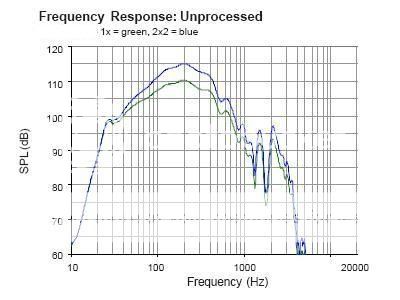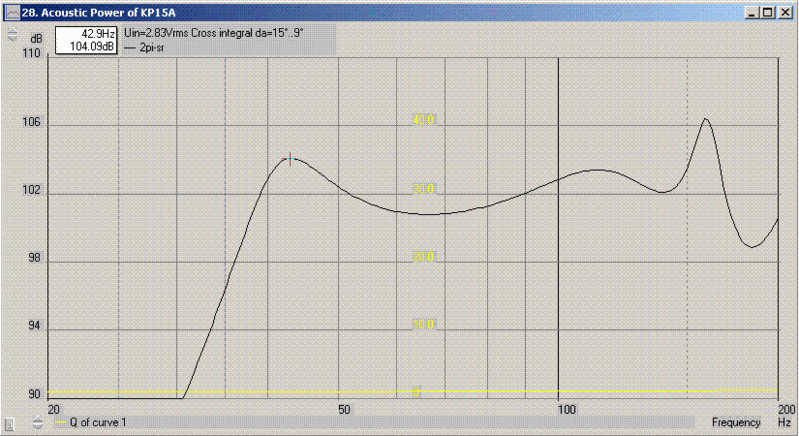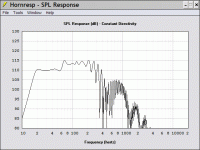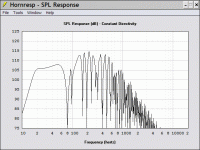Patrick Bateman said:Tom Danley made some comments on my Tapped Horn for Dummies thread that are quite interesting:
http://www.diyaudio.com/forums/showthread.php?postid=1598351#post1598351
Mark Seaton posted some really nice data comparing a tapped horn to a dual-reflex bandpass enclosure, AKA a 6th order bandpass:
http://www.diyaudio.com/forums/showthread.php?s=&threadid=114340&pagenumber=5
Don Snyder said:Is this a Tapped Horn?
I found this on Speakerplans.com and it has been widely built and tested. This nearly finished cabinet needs bracing and a side, and to be turned over.
Yep. This is one of those designs where L12 and L34 are nearly zero. They probably modeled it as a back-loaded horn, even though it's really a tapped horn. L12 and L34 can never go to zero, unless the cone was infinitely small right? For instance, with a 12" woofer they can't go any lower than 15.2cm right?
If you rotate the driver 90 degrees (so that the drivers cone fires straight down the horn path, L12 would be zero.
As far as S23 goes, I asume that when, with a single folded design like the transflex, if you end the horn at the axial position in front of the driver, S23 would be non-existant as well.
Regards Johan
As far as S23 goes, I asume that when, with a single folded design like the transflex, if you end the horn at the axial position in front of the driver, S23 would be non-existant as well.
Regards Johan
Altec 421-8H in a tapped horn.......
http://www.hostboard.com/cgi-bin/ultimatebb.cgi/ubb/get_topic/f/3729/t/3828#11
Due to its high Vas and low Xmax, it takes a ~1 k L cab to get a modest peak SPL over a wide BW using published specs, though only ~1.5 W to get there if corner loaded:
GM
http://www.hostboard.com/cgi-bin/ultimatebb.cgi/ubb/get_topic/f/3729/t/3828#11
Due to its high Vas and low Xmax, it takes a ~1 k L cab to get a modest peak SPL over a wide BW using published specs, though only ~1.5 W to get there if corner loaded:
GM
Attachments
Re: Altec 421-8H in a tapped horn.......
GM said:http://www.hostboard.com/cgi-bin/ultimatebb.cgi/ubb/get_topic/f/3729/t/3828#11
A tapped pipe OTOH is 'only' ~450 L, but the downside of course is a narrower ~20-80 Hz BW at a lower peak SPL (corner loaded as before):
GM
Attachments
Check out the response of a pair of tapped horn minis "in the real world."
+/- 3DB from 40hz to 200hz!
Even a sealed sub would be hard pressed to deliver that kind of performance. If you look at the graphs, a pair of th-minis is an order of magnitude smoother than a pair of labsubs.
NICE!
http://www.cobrasound.com/MDSubwoofers
+/- 3DB from 40hz to 200hz!
Even a sealed sub would be hard pressed to deliver that kind of performance. If you look at the graphs, a pair of th-minis is an order of magnitude smoother than a pair of labsubs.
NICE!
http://www.cobrasound.com/MDSubwoofers
An externally hosted image should be here but it was not working when we last tested it.
long time no see again, been to poor to work on anything,
the folded 30hz tapped horn looks very nice
mavo and mikehunt how are your new project going? i heard mavo was finally making sawdust
oh and as for my horn its dead now solid dead no air leaks im a real perfectionist, just had to add filler into one of the bolt gaps that was offside, im surprised it can blast 25hz so loud and clearly with only 6mm xmax, all my mates say its better than the clubs here (there rubbish)
one fear was that a lower tuning of the mikehunt/William design may be a bad combination, wasn't the case, recommend this sub for ambient/electronic and dub/dubstep
i do want to have a go with the smaller higher tuned box, looks very portable, nice designs.
yer so lemmie know
the folded 30hz tapped horn looks very nice
mavo and mikehunt how are your new project going? i heard mavo was finally making sawdust
oh and as for my horn its dead now solid dead no air leaks im a real perfectionist, just had to add filler into one of the bolt gaps that was offside, im surprised it can blast 25hz so loud and clearly with only 6mm xmax, all my mates say its better than the clubs here (there rubbish)
one fear was that a lower tuning of the mikehunt/William design may be a bad combination, wasn't the case, recommend this sub for ambient/electronic and dub/dubstep
i do want to have a go with the smaller higher tuned box, looks very portable, nice designs.
yer so lemmie know
ahhh what a blissfull clear low end these things have, great to smoke to, cheers guys 
mine does need a few 12" kick boxes for the high bass...
and these subs seem most uniform when aimed into a corner but with a meter or so to breath, my room dimensions do give me a almost irritating standing wave at 40hz, but the flat 30 and powerfull 23 stand out 20hz is alot lower in volume must be a room node...
must be a room node...
mine does need a few 12" kick boxes for the high bass...
and these subs seem most uniform when aimed into a corner but with a meter or so to breath, my room dimensions do give me a almost irritating standing wave at 40hz, but the flat 30 and powerfull 23 stand out 20hz is alot lower in volume
Patrick Bateman said:Check out the response of a pair of tapped horn minis "in the real world."
+/- 3DB from 40hz to 200hz!
Even a sealed sub would be hard pressed to deliver that kind of performance. If you look at the graphs, a pair of th-minis is an order of magnitude smoother than a pair of labsubs.
NICE!
http://www.cobrasound.com/MDSubwoofers
An externally hosted image should be here but it was not working when we last tested it.
TH-minis are indeed fantastic speakers for their size, but since they're about -10dB at 40Hz and -15dB at 35Hz (responses from the Maryland session and the Danley website agree on this) they don't really meet the original requirement to get down to 35-40Hz
Ian
P.S.
PYM1298
Anyone used or modeled this driver in a tapped horn?
http://www.mcmelectronics.com/product/55-2280
Looks to be very flat response and you can get the driver for around $70.
Anyone used or modeled this driver in a tapped horn?
http://www.mcmelectronics.com/product/55-2280
Looks to be very flat response and you can get the driver for around $70.
I've had a heck of a time finding suitable woofers for a tapped horn. Home audio drivers have an FS which is too low, so they're only appropriate for sub-bass tapped horns. Pro sound drivers are often promising candidates, but their xmax is lower than home audio drivers, which limits SPL in a huge way. And they're expensive.
Car audio drivers have often been the best choice for tapped horns, combining high FS and high xmax. For example, the Audax HT240G0 is $28 and is one of the best inexpensive woofers for experimenting with tapped horns.
Here's another interesting set of woofers, which I haven't seen anyone use. There's a niche of the car audio competition circuit called DB Drag, where sheer SPL is king. Because they're gunning for maximum output, the woofers have an FS which is higher than your typical car audio woofer, and re-donkulous power handling and xmax.
The woofers aren't cheap, but for $300 you can pick up a 2400 watt amplifier from Behringer and have fun with something like this:
http://www.mach5audio.com/zen/index.php?main_page=product_info&cPath=67&products_id=185
Car audio drivers have often been the best choice for tapped horns, combining high FS and high xmax. For example, the Audax HT240G0 is $28 and is one of the best inexpensive woofers for experimenting with tapped horns.
Here's another interesting set of woofers, which I haven't seen anyone use. There's a niche of the car audio competition circuit called DB Drag, where sheer SPL is king. Because they're gunning for maximum output, the woofers have an FS which is higher than your typical car audio woofer, and re-donkulous power handling and xmax.
The woofers aren't cheap, but for $300 you can pick up a 2400 watt amplifier from Behringer and have fun with something like this:
http://www.mach5audio.com/zen/index.php?main_page=product_info&cPath=67&products_id=185
1/2 pi loading is absurdly optimistic. These simulations would make a lot more sense if people would stop using it. It gives the readers of this forum the incorrect expectation that they're going to hit 120db with 100 watts. Do you know how much gain is added when you model in 1/2 pi instead of free air or half space?
Yes, of course...Patrick Bateman said:Do you know how much gain is added when you model in 1/2 pi instead of free air or half space?
As I said it drops ~5dB in quarter space; (actually 5.5dB).
In half space it drops 11dB.
I can't imagine using them in free space, so why model them that way.
As I said, I'm using them in corners, with concrete walls and floors...
So if everything goes wrong, and it acts like it's only half space, and only 99.5 dB @ one watt; ten watts is still 109.5 dB, more than I need...
I still say the Eminence Definimax 4012HO is a great driver for a TH, IF one is looking for good quality sound.
(not just looking permanant hearing damage-- I have no interest in "how loud can I make it)."
Patrick Bateman said:1/2 pi loading is absurdly optimistic. These simulations would make a lot more sense if people would stop using it. It gives the readers of this forum the incorrect expectation that they're going to hit 120db with 100 watts. Do you know how much gain is added when you model in 1/2 pi instead of free air or half space?
Hi Patrick, why do you think it is optimistic? Is this opinion based on measurements and if so, how were they done?
If the walls are made of concrete and the room doesnt have alot of leaks like doors and windows (which would be neccessary for it to behave like the model), i cant imagine why the predictions made by hornresp should be wrong. Hornresp does a great job at modelling horns, so i think it is strange to assume that exactly one aspect of its simulations would be way off. Actually, room response for corner placement should be even better than 0,5PI simulations because you have a ceiling and the room gain below the lowest room mode, which both is not simulated in hornresp.
The modeling programs assume the walls of the horn and walls of the room are made of something real dense, like depleted uranium.
In real life we don't 'quite' get that level of performance.
Here is a bass horn, 3/4" Baltic birch, well braced. Notice how going from one to four gets you maybe 1dB~1.5dB in the 30hz region, and doesn't go any lower?

The modeling programs all show a different story.
In real life we don't 'quite' get that level of performance.
Here is a bass horn, 3/4" Baltic birch, well braced. Notice how going from one to four gets you maybe 1dB~1.5dB in the 30hz region, and doesn't go any lower?

The modeling programs all show a different story.
djk said:The modeling programs assume the walls of the horn and walls of the room are made of something real dense, like depleted uranium.
Hi djk,
Hornresp assumes non-vibrating Kryptonite, actually
Kind regards,
David
Interesting information, djk, but i have some concerns, which conflict with it.
Placing several horns close together is the same as having one big horn with one big driver. Following this, the picture implies that a big horn has relatively more losses than a small one. Since this is not the case, or else simulations of speakers would be totally unusable, i think something is wrong with this picture, either within the measurement itself, the measured loudspeakers or its application as an argument here.
Assuming this picture IS right, i dont see its validity concerning a room with concrete walls, which are quite solid in comparison to air and dont vibrate alot more than the lovely non vibration kryptonite (which is also valid for a well braced box i assume).
(which is also valid for a well braced box i assume).
After all, i just theorise here, having no clues whatsoever to support my position. So take this all with a grain of salt.
Placing several horns close together is the same as having one big horn with one big driver. Following this, the picture implies that a big horn has relatively more losses than a small one. Since this is not the case, or else simulations of speakers would be totally unusable, i think something is wrong with this picture, either within the measurement itself, the measured loudspeakers or its application as an argument here.
Assuming this picture IS right, i dont see its validity concerning a room with concrete walls, which are quite solid in comparison to air and dont vibrate alot more than the lovely non vibration kryptonite
After all, i just theorise here, having no clues whatsoever to support my position. So take this all with a grain of salt.
- Home
- Loudspeakers
- Subwoofers
- Collaborative Tapped horn project





